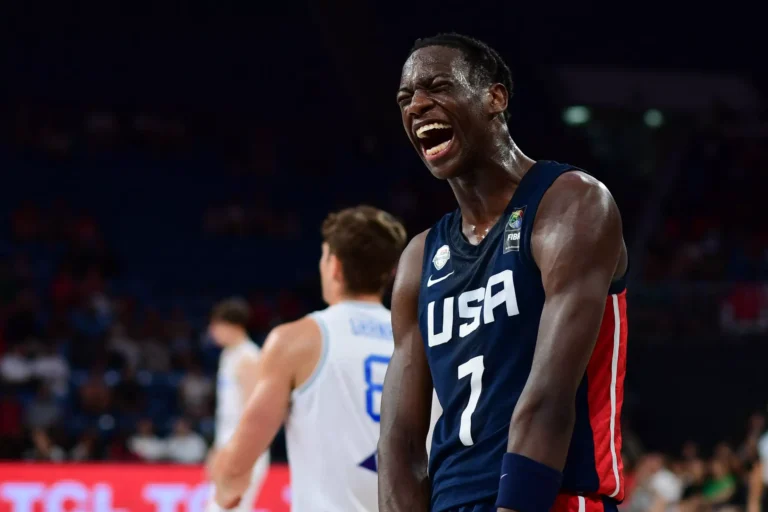COLUMBIA, S.C. – South Carolina’s dominance in women’s college basketball under head coach Dawn Staley continues to reach new heights, yet it’s easy to forget that not long ago, the Gamecocks’ success this past season seemed far from guaranteed. Just six months after finishing a flawless 38-0 season and winning a third national championship, South Carolina now stands as the preseason No. 1 in the USA TODAY Sports women’s basketball coaches poll and is heavily favored to defend its title. But, as Staley knows well, with this success comes an ever-growing challenge: how long can the Gamecocks maintain their place at the top?
South Carolina’s 2023 championship season came as a surprise even within the program. The roster was filled with young talent but had question marks at key positions and some growing pains to address, including issues like punctuality and conditioning. “When we started [last] summer, it was like, ‘You’ve got to be kidding me,’” said associate head coach Lisa Boyer. “Just stuff that we had not had to deal with, like being on time and returning text messages. They were out of shape. They weren’t ready. There was no connection, no leadership.”
Despite these early hurdles, South Carolina’s young team transformed into a cohesive powerhouse, achieving a perfect season that cemented Staley’s program as the new dynasty in women’s college basketball. Heading into her 17th season, Staley acknowledges the difficulty in sustaining such success, especially as NIL, the transfer portal, and increased competitiveness across women’s college basketball continue to reshape the sport. “I do know that the pace that we’re winning, it’s hard to sustain,” she shared. “If we take a loss this year, the bottom will fall out.” But despite Staley’s lighthearted comment, South Carolina appears to be operating at its peak, having gone undefeated in SEC play since December 2021 and reaching four straight Final Fours.
The Gamecocks’ success has largely been unaffected by the transfer portal, even as talented players could potentially seek more prominent roles elsewhere. This is a testament to Staley’s program culture, which emphasizes team chemistry and shared goals over individual accolades. Last season, South Carolina’s depth was so impressive that seven different players led the team in scoring at different times, often with different top scorers from one game to the next. This balance of talent, rather than reliance on a singular star, is what Boyer believes keeps the team so effective, allowing players to step up when needed without vying for personal glory.
Beyond on-court success, Staley’s ability to connect with her players and build a culture rooted in respect and collaboration has proven essential. Having evolved from her early days as a head coach, Staley now emphasizes relationship-building with recruits and their families, using these bonds to navigate the challenges players often face. For Staley, it’s a “full service” approach, extending beyond basketball to support her athletes’ well-being and growth. This holistic approach, she explains, not only prepares players for the game but for the demands of life and future professional careers.
In recruiting, Staley places an emphasis on honesty, often pushing her players to balance ambition with the team’s needs. “They want it all. They want to win, they want to get drafted, they want championships. They want it all, but sometimes there’s a sacrifice to success,” she said, noting that for some players, the pressure of their future ambitions can create distraction. Staley’s role, then, is to keep her players grounded, focusing on team goals rather than individual pursuits. This strategy has paid off, with South Carolina producing multiple WNBA draft picks, including Aliyah Boston, who went No. 1 overall in the draft, and Kamilla Cardoso, who dominated last season’s Final Four and was picked second.
The Gamecocks’ success under Staley has not only transformed South Carolina’s basketball program but also its fan base, with the team regularly drawing over 16,000 fans to Colonial Life Arena. This strong support, combined with Staley’s continued commitment to the program, has allowed South Carolina to flourish, despite Staley having opportunities to move to professional leagues like the NBA or WNBA. “This is where I’m supposed to be,” Staley said. “I’m doing what I’m supposed to be doing. I don’t think I’m supposed to be coaching in the NBA or the WNBA. This is real natural – like, natural.”
As South Carolina enters a new season, the Gamecocks find themselves not only as favorites to win it all again but as the target every opponent wants to defeat. Boyer said it best: “We’re talking to them right now like, you know, nobody likes you, OK? Everybody hates you now. Everybody wants you to lose. The cuteness is over.” With this mindset, South Carolina is preparing to face the heightened expectations that come with being the reigning champions.
For Staley, who was once a Hall of Fame player herself, coaching this team means balancing the big picture with the day-to-day needs of her players. While she has developed a recipe for success, she recognizes that her approach must evolve each season to address the shifting dynamics of her team and the demands of today’s college basketball landscape. Her program’s ability to cultivate individual strengths while prioritizing team success has kept South Carolina at the pinnacle of the sport, setting a new standard for what it means to build a dynasty in women’s college basketball.
This year, South Carolina faces not only the challenge of defending a title but of continuing to grow as a team and finding new ways to stay motivated. It’s a journey Staley is well-equipped to guide, and if last season’s accomplishments are any indication, South Carolina seems poised to remain a powerhouse for years to come.






